After months of threats, Vladimir Putin has declared war on Ukraine, launching a full-scale invasion throughout Russia’s neighbouring country.
The ground and air attack, the biggest offensive between European states since the Second World War, has caused bloodshed in a peaceful country, and prompted condemnation from within Russia and the world over.
But for many people trying to keep up with the news, staying informed can be bewildering. Much of the reporting and commentary involves jargon and assumed political and historical knowledge.
Here, HuffPost UK explains some of the key terms and talking points to help make sense of a conflict that could continue for months.
What is the relationship between Russia and Ukraine?
With the 1991 break-up of the Soviet Union, Russia lost control of 14 former republics it had previously dominated – including Ukraine.
The two countries had been linked since the 9th century when Kyiv became the capital of the ancient state of Rus. From 1654, Russia and Ukraine were united by treaty under the rule of the Russian tsar.
The two countries speak closely-related languages and later formed, with Belarus, the Slav core of the Soviet Union. Many Russians feel a connection with Ukraine that they do not feel with other former Soviet republics.
But, to be clear, Ukraine has been its own nation-state for three decades, boasts its own distinct language and customs, and has long had an impulse for nationalism. Locals want the capital to be known as Kyiv not Kiev, which has Russian roots. Enthusiasm for independence in 1991 was almost total: some 92.3% of voters said they would prefer the country to be free.
The Rest Is History podcast has recorded a highly informative episode on Ukraine’s past for British listeners (note the comparison between Britain’s relationship with Ireland, and Russia-Ukraine). It is particularly strong on essaying Ukraine’s grim last century, which has seen millions of people dying because of starvation, war and brutal leadership.
What is Nato?
The military alliance that goes by the acronym of Nato is central to recent events.
The North Atlantic Treaty Organisation was formed in 1949 to prevent a resurgence of nationalism and militarism in Europe after two world wars, and to deter the Soviet Union’s expansion.
Its membership has swelled to 30 member nations, and over the 1990s and 2000s its enlargement stretched further east to include the former Soviet republics of Estonia, Latvia and Lithuania.
They agree to mutual defence – military action – in response to an enemy attack. The principle goes: “An attack against one ally is considered as an attack against all allies.” This is Article 5 of the Nato constitution.
Ukraine is not a member of Nato – but admission has been a stated goal going back to its constitution in 2002. If it joined, the move would likely pave the way for Ukraine to became part of the European Union too, further undermining Russia’s grip.
Nato’s enlargement has been Putin’s biggest publicly-stated grievance with the West during the build-up up to war, claiming the eastward expansion and potentially sweeping up the largest other former Soviet republic breaks promises. Nato has been adamant it will not accept limits on the nations that it admits and has always maintained an “open door policy”.
In a word: from “oligarchs” to the “West”
Many of the pronouns used in news and analysis are not widely understood by all. The West is a catch-all term used to describe a loose alliance of countries broadly representing the “Western world” – broadly Europe, north and south America, and Australasia, specifically the US, UK, France and Germany, who wield the most influence.
A political capital is often a substitute for a country’s government, hence Ukraine is referred to as Kyiv, Russia as Moscow (or the Kremlin), the US is Washington and so on.
Stemming from an ancient Greek word “oligarkhia”, which means the rule of the few, oligarch is a term applied to business tycoons created in the fall-out of the rapid privatisation of Russia in the 1990s. Many – also nicknamed kleptocrats – have homes and interests in the UK and have found London (dubbed Londongrad) to be their playground.
Sanctions has been commonly used in recent weeks, and put simply they are measures imposed on a state, group or individual as punishment for certain actions. Diplomatic sanctions could mean getting rid of a state’s embassy, and these options have largely been exhausted on Russia. Military sanctions are the most powerful tool, but are unlikely to be deployed to the extreme given the threat of nuclear weapons.
It means the main response has been the threat of crippling economic sanctions – including measures targeting the private wealth of Putin’s cronies in the West, such as freezing their assets. While the early economic crackdowns were criticised for being toothless, ramped up financial sanctions have been called unprecedented that are already having devastating consequences for ordinary Russians.
What is Putin trying to achieve?
As has often been stated, no-one fully understands what Putin’s plans truly are. However, most commentators point towards Putin’s description in 2005 of the collapse of the Soviet Union as “the greatest geopolitical catastrophe of the century”. One assessment of Putin’s goals is that he wants Ukraine to remain inside Russia’s sphere of influence – its “near abroad” – and re-establish something akin to the old USSR. One model could be to turn Ukraine into Belarus, Russia’s ally and a fellow dictatorship that has rejected moves towards democracy.
But his aims might be more ambitious given Putin’s allusions to the wider Russian empire and his previous backing of separatists in Moldova and Georgia. Through the years, Putin has made it clear that he does not consider Ukraine to be a real country, a point he made again during a protracted and angry speech this week where he he referred not to the loss of the Soviet Union but to the “territory of the former Russian empire”.
Whatever the scale, some analysts believe the 69-year-old may be looking to secure his own legacy and take care of unfinished business after more than two decades as Russia’s de facto leader.
What happened in Crimea?
The current difficulties date back to 2014 and the Crimean Peninsula in southern Ukraine, where Putin’s aggression became clear.
The overthrow of the pro-Russian Ukrainian government of Viktor Yanukovych prompted fears in the Kremlin that the country was moving out of its orbit. Putin responded by sending in troops to seize Crimea, or what’s referred to as an annexation.
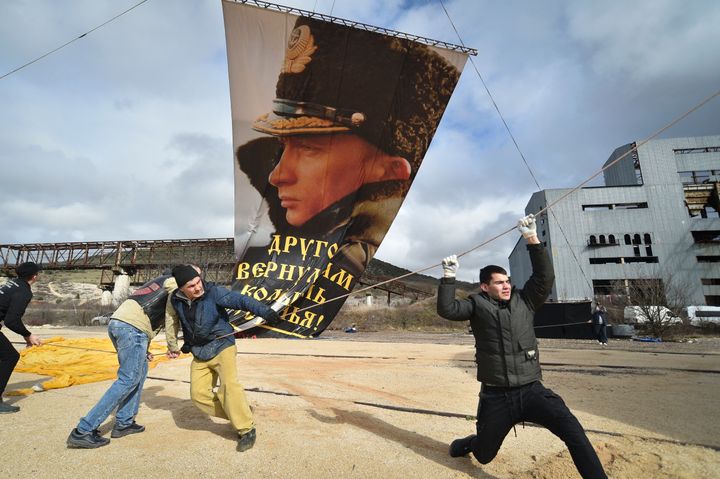
Crimea has long been contested. Absorbed into the Russian empire by Catherine the Great in the 18th century, the peninsula was part of Russia within the Soviet Union until 1954, when it was handed to Ukraine by Soviet leader Nikita Khrushchev.
Periodic political tussles over its status continued after the collapse of the Soviet Union, until elite Russia troops were able to seize the peninsula without firing a shot eight years ago.
What is the significance of Donetsk and Luhansk?
Putin had to create a pretext to invade Ukraine. A fabrication, in other words, and he used the regions of Donetsk and Luhansk to do this.
The annexation of Crimea came at the same time as Russia provided backing to separatists who are still fighting government forces in Ukraine’s eastern industrial heartland of Donbas. The conflict has claimed at least 14,000 lives.
The Ukraine government has long-feared Russia would attempt to annex the area, and has criticised Moscow’s efforts to ratchet up tension in the two areas, which are overwhelmingly Russian speaking.
This week, he recognised the two regions as independent and dispatched troops to the territories, under the guise of “peace keeping”. Entering a sovereign country was universally branded a violation of international law. Putin used the same false justification for his incursion into wider, peaceful Ukraine.
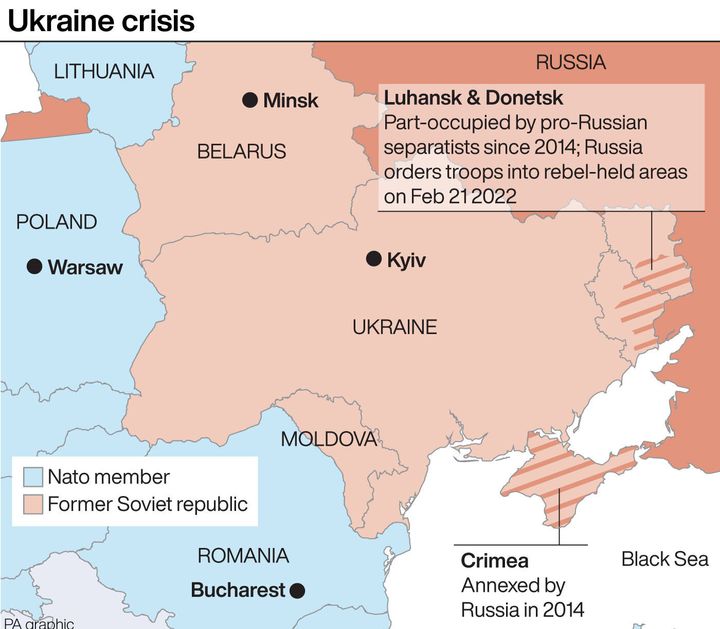
Is this “world war three”?
It seems very unlikely the West will intervene militarily. Ukraine is not a member of Nato, so there is no obligation on alliance members to come to its defence. There is little appetite in Western capitals for a military conflict with Moscow.
Allies from across the world have been sending military support to Kyiv – the US sending $350 million in weapons, including Javelin anti-tank weapons, underlined the growing aid being dispatched – and there have also been moves to bolster alliance forces in Nato’s eastern members, with additional troops sent to Poland and Estonia.
When asked this month what kind of scenarios would prompt a US rescue mission, US president Joe Biden said: “There’s not (one). That’s a world war – when Americans and Russians start shooting at one another, we’re in a very different world than we’ve ever been in.”
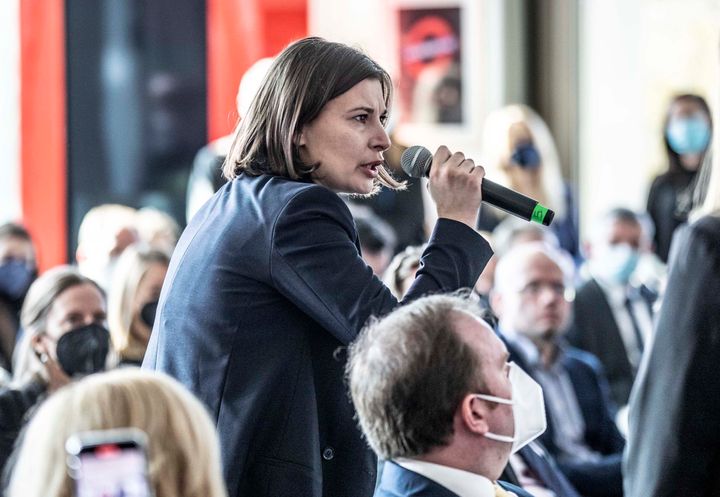
However, there are fears the war in Ukraine could lead to clashes with neighbouring countries such as Poland, which is a Nato member, which would up the ante dramatically.
And Ukrainian activist Daria Kaleniuk, when confronting Boris Johnson during a press conference in Poland, suggested the West had become bogged down in semantics, when calling for a “no-fly zone”.
She said: “Nato is not willing to defend because Nato is afraid of world war three – but it’s already started and it’s Ukrainian children who are there taking the hit.”
What is a no-fly zone?
Ukrainian president Volodymyr Zelenskyy has urged the West to consider a no-fly zone for Russian aircraft over Ukraine to prevent bombings from Putin’s planes. But the US and its allies are unlikely to grant the wish because of the fear – as set out above – of triggering a wider war with Russia.
In a video address, Zelenskyy said it was time to block Russian missiles, planes and helicopters from Ukraine’s airspace. It came after Russian attacks in Kharkiv, a city of 1.4 million people, had killed civilians, including children.
In recent decades, a no-fly zone has been used by Western alliances during conflicts in Iraq, Bosnia and Libya. A no-fly zone (NFZ), or air exclusion zone (AEZ), would mean prohibiting military aircraft from entering a designated airspace. It would be enforced by surveillance, preemptive strikes and by attacking any planes that violate the ban.
But Nato allies have consistently voiced caution, as direct clashes between Nato forces and Russian planes would be interpreted as an act of war by Putin. The US has made clear its concern about further escalating tensions between the world’s two biggest nuclear powers.
White House press secretary Jen Psaki told reporters that “a no-fly zone would require implementation”. Such a move would require “deploying US military to enforce, which would be ... potentially a direct conflict, and potentially a war with Russia, which is something we are not planning to be a part of”.
UK prime minister Boris Johnson said: “I think for any Nato member to get involved actively in conflict with Russia is a huge step which is not being contemplated by any member.”
What is the Minsk agreement?
A two-part agreement – signed in the Belarusian capital in 2014 and 2015 – between Russia and Ukraine intended to scale back the fighting in the Donbas region of Ukraine. The Russian invasion violated the settlement, Western leaders said.
So-called “Minsk I” saw Ukraine and the Russian-backed separatists agree a 12-point ceasefire deal. Provisions included prisoner exchanges, deliveries of humanitarian aid and the withdrawal of heavy weapons, five months into a conflict that had by then killed more than 2,600 people at the time. The agreement quickly broke down.
Representatives of Russia, Ukraine, the Organisation for Security and Cooperation in Europe and the leaders of two pro-Russian separatist regions signed a 13-point agreement under “Minsk II”.
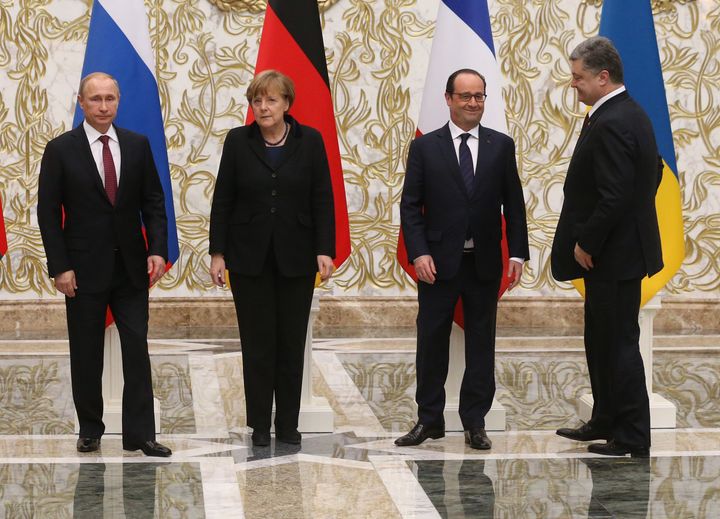
The leaders of France, Germany, Russia and Ukraine, gathered in Minsk at the same time, issued a declaration of support for the deal.
It set out military and political steps that remain unimplemented. A major blockage has been Russia’s insistence that it is not a party to the conflict and therefore is not bound by its terms.
Point 10, for example, calls for the withdrawal of all foreign armed formations and military equipment from the two disputed regions of Donetsk and Luhansk: Ukraine says this refers to forces from Russia, but Moscow denies it has any forces there.
What are humanitarian corridors?
A humanitarian corridor is a temporary pause of armed conflict, agreed by both sides, to allow food and medical aid to be brought to a warzone, or for civilians to evacuate.
These demilitarised zones are in most cases negotiated by the United Nations, and are seen as vital to avoiding a humanitarian catastrophe, especially when international law is breached by the shelling of civilians.
Humanitarian corridors have been used since the mid-20th century. During the so-called Kindertransport from 1938 to 1939, Jewish children were evacuated to the UK from areas under Nazi control. They were also created during the siege of Sarajevo, Bosnia, in the 1990s and the 2018 evacuation of Ghouta, Syria.
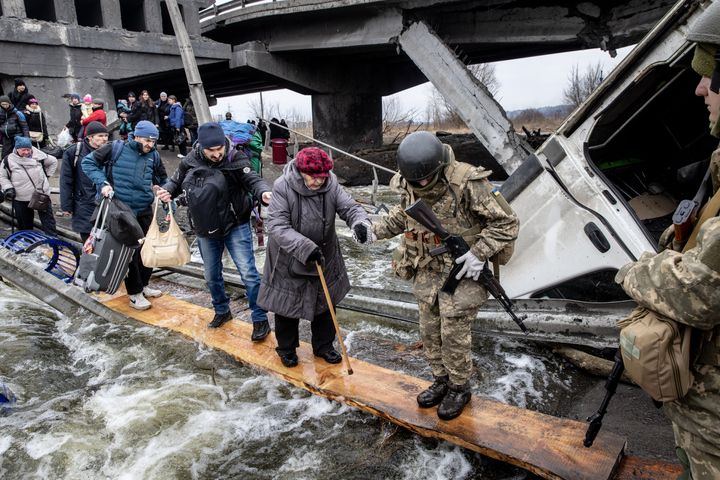
Access is typically limited to neutral parties, such as the UN or aid organisations including the Red Cross.
The Russian invasion has pushed 1.5 million people to flee the country, creating what the head of the UN refugee agency called “the fastest-growing refugee crisis in Europe since World War II”.
Russia announced new “humanitarian corridors” to provide safe passage for Ukrainian civilians fleeing the invasion. But the limited ceasefire was dismissed by Ukraine and Western allies as an immoral stunt, as the escape routes would only take displaced people to Russia and its ally Belarus.
What is a vacuum or thermobaric bomb?
Human rights groups have accused Russian forces of using widely-banned cluster munitions in Ukraine.
A vacuum bomb, or thermobaric weapon, is considered much more devastating than conventional explosives of similar size. It sucks in oxygen to generate a high-temperature explosion. It typically produces a longer blast wave than that of a conventional explosive and can vaporize human bodies.
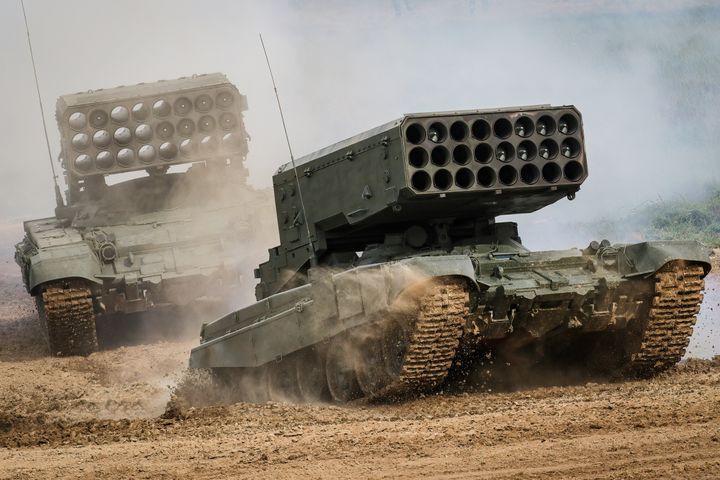
Amnesty International said international humanitarian law prohibits the use of indiscriminate weapons, and that launching these attacks that kill or injure civilians constitutes a war crime.
Oksana Markarova, Ukraine’s ambassador to the United States, has accused Russia of using a vacuum bomb during its invasion, but there has been no official confirmation that thermobaric weapons have been used in the conflict.
What is the Nord Stream 2 pipeline?
The undersea natural gas pipeline directly links Russian gas to Europe via Germany and is complete but not yet operating. It has become a major target as Western governments try to exert leverage on Russia to deter further military moves.
After Russia recognised separatist-held regions in eastern Ukraine, German chancellor Olaf Scholz suspended the certification process for the pipeline. Scholz said on Tuesday that Russia recognising the independence of rebel-held areas in Ukraine marked a “serious break of international law” and that it was necessary to “send a clear signal to Moscow that such actions won’t remain without consequences”.
Europe is a key market for state-owned gas giant Gazprom, whose sales support the Russian government budget. Europe needs gas because it’s replacing decommissioned coal and nuclear plants before renewable energy sources such as wind and solar are sufficiently built up.
While Europe needs Russian gas, Gazprom also needs the European market. That interdependence is why many think Russia won’t cut off supplies to Europe, and Russian officials have underlined they have no intention to do that.
Why does China matter?
Boris Johnson flagged the risk for Taiwan in a warning about the damaging consequences if Western nations failed to support Ukraine’s independence.
China, which claims Taiwan as its own territory, has stepped up military activity near the self-governing island over the past two years, though Taiwan has reported no recent unusual moves by Chinese forces as tension over Ukraine has spiked.
The defeated Republic of China government fled to Taiwan in 1949 after losing the civil war to the Communists, who set up the People’s Republic of China. Taiwan’s government strongly opposes China’s territorial claims.
Taiwan President Tsai Ing-wen called for the island to beef up vigilance on military activities in response to the Ukraine crisis.
What is SWIFT?
The Ukraine is urging the the West to go further than promised sanctions and cut the Russians from the SWIFT system, a key financial network that connects thousands of banks around the world.
Belgium-based SWIFT, a messaging network widely used by banks to send and receive money transfer orders or information, is overseen by central banks in the United States, Japan and Europe.
Ukraine’s foreign minister Dmytro Kuleba tweeted those who opposed Russia being blocked from the SWIFT payment system would have “the blood of innocent Ukrainian men, women and children… on their hands”.
The White House had been reluctant to immediately cut Russia from SWIFT, worried it could cause enormous economic problems in Europe and elsewhere in the West, and allies appeared divided.
But the US, the European Union, the UK and Canada later put out a joint statement later put out a joint statement saying that they would disconnect “selected” Russian banks from SWIFT.
This story will be updated throughout the conflict.

